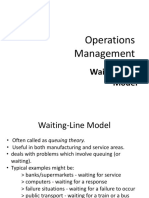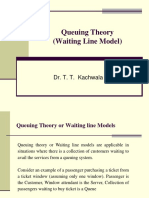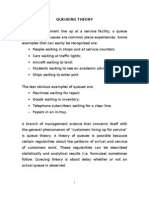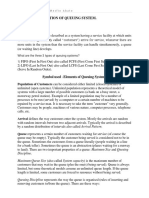0 ratings0% found this document useful (0 votes)
AE4-Activity 9 - Problem On Queuing Theory
AE4-Activity 9 - Problem On Queuing Theory
Uploaded by
Lyka mae LabadanThe document discusses two queuing theory problems: 1) a single clerk system with an average arrival of 2 customers per hour and service rate of 30 customers per hour. It asks to calculate average customers in system, waiting, and times spent in system and queue as well as system busy percentage. 2) A multi-server bank system with 3 loan officers serving 4 customers per hour on average and 10 average arrivals per hour, asking to calculate probability of empty system, average customers in system and queue, and average times in system and queue as well as probability all servers busy.
Copyright:
© All Rights Reserved
Available Formats
Download as DOCX, PDF, TXT or read online from Scribd
Download as docx, pdf, or txt
AE4-Activity 9 - Problem On Queuing Theory
AE4-Activity 9 - Problem On Queuing Theory
Uploaded by
Lyka mae Labadan0 ratings0% found this document useful (0 votes)
The document discusses two queuing theory problems: 1) a single clerk system with an average arrival of 2 customers per hour and service rate of 30 customers per hour. It asks to calculate average customers in system, waiting, and times spent in system and queue as well as system busy percentage. 2) A multi-server bank system with 3 loan officers serving 4 customers per hour on average and 10 average arrivals per hour, asking to calculate probability of empty system, average customers in system and queue, and average times in system and queue as well as probability all servers busy.
Original Title
AE4-Activity 9 - Problem on Queuing Theory (1)
Copyright
© © All Rights Reserved
Available Formats
DOCX, PDF, TXT or read online from Scribd
Share this document
Did you find this document useful?
Is this content inappropriate?
The document discusses two queuing theory problems: 1) a single clerk system with an average arrival of 2 customers per hour and service rate of 30 customers per hour. It asks to calculate average customers in system, waiting, and times spent in system and queue as well as system busy percentage. 2) A multi-server bank system with 3 loan officers serving 4 customers per hour on average and 10 average arrivals per hour, asking to calculate probability of empty system, average customers in system and queue, and average times in system and queue as well as probability all servers busy.
Copyright:
© All Rights Reserved
Available Formats
Download as DOCX, PDF, TXT or read online from Scribd
Download as docx, pdf, or txt
0 ratings0% found this document useful (0 votes)
AE4-Activity 9 - Problem On Queuing Theory
AE4-Activity 9 - Problem On Queuing Theory
Uploaded by
Lyka mae LabadanThe document discusses two queuing theory problems: 1) a single clerk system with an average arrival of 2 customers per hour and service rate of 30 customers per hour. It asks to calculate average customers in system, waiting, and times spent in system and queue as well as system busy percentage. 2) A multi-server bank system with 3 loan officers serving 4 customers per hour on average and 10 average arrivals per hour, asking to calculate probability of empty system, average customers in system and queue, and average times in system and queue as well as probability all servers busy.
Copyright:
© All Rights Reserved
Available Formats
Download as DOCX, PDF, TXT or read online from Scribd
Download as docx, pdf, or txt
You are on page 1/ 1
Problem on Queuing Theory
I. Single-channel/Single Phase System
A clerk can serve thirty (30) customers per hour on the average. Twenty (2) customers
arrive each hour on average. Compute:
1. The average number of customers in the system (Ls)
2. The average number of just waiting in line (Lq)
3. The average customer time spent in the system (Ws)
4. The average customer time spent in the queue (Wq)
5. The percentage of time the system is busy.
II. Multi-channel/Single-Phase System
A bank has three (3) loan officers on duty, each of whom can serve four (4) customers
per hour. Every hour, ten (10) loan applicants arrive at the loan department and join a
common queue. What are the system’s operating characteristics?
1. The probability of zero (0) customer in the system (P0)
2. Average number of customers in the system (Ls)
3. Average number of customers in the queue (Lq)
4. Average waiting time of each customer in the system (Ws)
5. Average waiting time of each customer in the queue (Wq)
6. The probability that all the system servers are currently busy (P w)
You might also like
- Introduction To Management Science 8th Edition by Bernard W. Taylor IIINo ratings yetIntroduction To Management Science 8th Edition by Bernard W. Taylor III58 pages
- Queuing or Waiting Line Theory: Single Server System Multi Server SystemNo ratings yetQueuing or Waiting Line Theory: Single Server System Multi Server System59 pages
- Operations Management: Waiting-Line ModelNo ratings yetOperations Management: Waiting-Line Model15 pages
- Queuing Models: Mee1024 Operations ResearchNo ratings yetQueuing Models: Mee1024 Operations Research31 pages
- Service Operations and Queueing - Module DNo ratings yetService Operations and Queueing - Module D34 pages
- Waiting Line Management: Ravindra S. GokhaleNo ratings yetWaiting Line Management: Ravindra S. Gokhale30 pages
- MGSC 395 - Supplement B - Waiting Lines - Fall 2023No ratings yetMGSC 395 - Supplement B - Waiting Lines - Fall 202331 pages
- Introduction To Management Science: Queuing TheoryNo ratings yetIntroduction To Management Science: Queuing Theory26 pages
- Karatina University Karatina University Karatina University BBM 355: Operations Research 1 Queuing Theory (Waiting Line Models)No ratings yetKaratina University Karatina University Karatina University BBM 355: Operations Research 1 Queuing Theory (Waiting Line Models)75 pages
- Introduction To Manufacturing Systems EngineeringNo ratings yetIntroduction To Manufacturing Systems Engineering52 pages
- Ch1. The Little Law in Operations ManagementNo ratings yetCh1. The Little Law in Operations Management22 pages
- Case Study For Bank ATM Queuing Model: Cite This PaperNo ratings yetCase Study For Bank ATM Queuing Model: Cite This Paper6 pages
- Filtering, Control and Fault Detection with Randomly Occurring Incomplete InformationFrom EverandFiltering, Control and Fault Detection with Randomly Occurring Incomplete InformationNo ratings yet
- Performance Evaluation by Simulation and Analysis with Applications to Computer NetworksFrom EverandPerformance Evaluation by Simulation and Analysis with Applications to Computer NetworksNo ratings yet
- San Miguel Corporation: Learning About A BusinessNo ratings yetSan Miguel Corporation: Learning About A Business55 pages
- Labadan, Lyka Mae S. CBET-01-502A: Economic DevelopmentNo ratings yetLabadan, Lyka Mae S. CBET-01-502A: Economic Development3 pages
- QUIZ C4 Sec. 35-58 CORP. NAME - Set-A True or FalseNo ratings yetQUIZ C4 Sec. 35-58 CORP. NAME - Set-A True or False1 page
- Sales Quiz 6 Set-B SURNAME First - : ExpropriationNo ratings yetSales Quiz 6 Set-B SURNAME First - : Expropriation1 page






































































